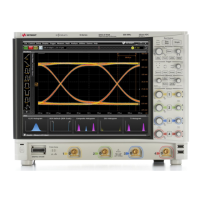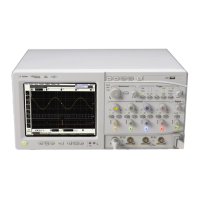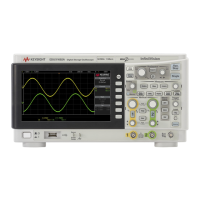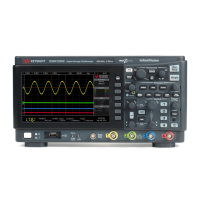Do you have a question about the Keysight Infiniium MXR Series and is the answer not in the manual?
| Brand | Keysight |
|---|---|
| Model | Infiniium MXR Series |
| Category | Test Equipment |
| Language | English |
Important warnings and precautions for safe operation and product maintenance.
Steps to verify received items and check for shipping damage.
Operating and non-operating conditions for temperature, humidity, and altitude.
Guidelines for placing the oscilloscope to ensure adequate ventilation.
How to adjust the oscilloscope's tilt for optimal visibility.
Instructions for connecting peripherals and network cables to the unit.
Procedure for safely connecting the oscilloscope to a power source.
Steps to power on the oscilloscope and understand its initial startup.
Guidance on securing the oscilloscope by changing the default password.
Description and location of input/output ports on the front of the oscilloscope.
Description and location of motherboard I/O and other connectors on the side panel.
Details about the connector for digital channels, including MSO option.
Description of the General Purpose Output connector for waveform signals.
Description of the Auxiliary Output connector for various signal types.
Function of the 10 MHz reference input for timebase synchronization.
Function of the 10 MHz reference output for external synchronization.
Description of the Auxiliary Trigger Input connector for triggering on external signals.
Description of the Trigger Output connector for external trigger events.
Overview of the front panel controls, including knobs and function keys.
Explanation of the oscilloscope's on-screen display and user interface elements.
Instructions on how to connect probes to the oscilloscope channels.
Step-by-step guide to confirm the oscilloscope is functioning correctly.
How to reset to default settings or automatically scale the display.
Procedures for initiating, pausing, and stopping data acquisition.
How to clear the screen to prepare for new acquisitions.
Controls for setting the timebase scale and position of waveforms.
How to adjust the trigger point relative to the acquired waveform data.
Using the zoom function to view specific sections of the waveform.
Features for navigating through acquisition history and segmented data.
Adjusting horizontal parameters and defining the timebase reference.
Controls for setting the vertical scale and offset for analog channels.
How to enable or disable individual analog channel displays.
Fine-tuning the vertical display parameters for each analog channel.
Controls related to trigger settings and other front panel functions.
Description of the multi-function knob for adjusting values in dialog boxes.
Functionality of the configurable multi-purpose key for quick actions.
Configuration options for different types of trigger conditions.
Using the built-in generator to create various signal waveforms.
How to capture and save screen images or print measurement data.
Utilizing touch gestures for oscilloscope operation and parameter adjustment.
Displaying and adjusting markers for precise waveform measurements.
Procedures for performing automated measurements on waveforms.
Utilizing preset measurements for rapid analysis.
Operating digital channels and decoding serial communication protocols.
How to use the built-in demo wizard to explore oscilloscope features.
Methods for accessing the oscilloscope's integrated help system.
Guidance on modifying OS settings without affecting oscilloscope operation.
Instructions for installing compatible third-party software on the oscilloscope.
Steps to perform a full reset to factory default settings when issues arise.
Procedures for recovering the oscilloscope's hard drive in case of failure.
Safe methods for cleaning the oscilloscope's external surfaces.
Criteria for determining when a user calibration is necessary.
List of necessary equipment for performing calibration procedures.
Estimated time required to complete the user calibration process.
Step-by-step instructions for performing a user calibration.
Overview of performance testing procedures and intervals.
Procedure to verify the oscilloscope's input impedance accuracy.
Test to measure the accuracy of the vertical offset setting.
Procedure to verify the accuracy of the DC gain measurement.
Test to measure the oscilloscope's analog bandwidth performance.
Procedure to verify the accuracy of the oscilloscope's timebase.
Template for recording test results and limits.
Steps to confirm the oscilloscope is functioning correctly after startup.
Performing internal diagnostic tests to check system functionality.
Specific self-tests for front panel components and touch screen.
Procedure to verify the functionality of all front panel LED indicators.
Steps to confirm the responsiveness and accuracy of the touch screen.
Instructions for performing a self-calibration to optimize performance.
Procedures to ensure the oscilloscope meets all warranted specifications.
Information to gather and save before contacting technical support.
Steps and information required for sending the oscilloscope for repair.











